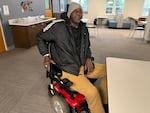Otis Britton remembers a car speeding toward him like it was on a race track.
On the early morning of Nov. 5, 2021, Britton and his friend, Laurie Lawyer, were standing in a bike lane near the intersection of Interstate Avenue and North Going Street in Portland. They were right next to the homeless encampment where they both lived.
The two had been just starting a drive to Swan Island to drop off food for a different homeless encampment when something flew out the back of the truck and into the bike lane, Britton recounted in a January interview with OPB. He said Lawyer pulled over to the right side of the road and turned on her hazards and headlights.
They were retrieving the item when a driver came barreling toward them at what Britton guesses was 80 or 90 miles per hour. The speed limit in the area is 30 miles per hour.
The car hit them both. Britton, 54, survived the accident. Lawyer, 56, died at the scene, one of 19 pedestrians killed by cars in 2021 while living on Portland streets.

Otis Britton, 54, is in a wheelchair after a driver hit him and his friend on Interstate Avenue. Britton, who camps nearby, said he spent 50 days in the hospital. His friend, Laurie Lawyer, died at the scene.
Rebecca Ellis / OPB
Deaths such as Lawyer’s are becoming increasingly common as more camps crop up near major roadways and traffic deaths reach record-setting levels. A report out Wednesday from the Portland Bureau of Transportation found 70% of the 27 pedestrians hit and killed by cars last year were experiencing homelessness when they died.
The annual report laid bare just how far the city is from realizing its Vision Zero policy, which set a goal of eliminating all traffic deaths by 2025. In 2021, despite spending tens of millions on the campaign in the last several years, the city saw the highest number of traffic fatalities since 1990, according to the report – an annual total of 63 deaths. Twenty-seven people died while in motor vehicles and nine died on motorcycles. Twenty-seven pedestrians were killed.
Nineteen of them were homeless.
“We are confident these numbers are far and away higher than anything we’ve experienced in Portland,” said Dylan Rivera, a spokesperson with the city’s transportation bureau.
Rivera said that in past years, the number of homeless people who died in car crashes ranged from “zero to a handful.” He said bureau officials are not clear what’s causing the jump in traffic deaths, though they suspect reckless driving has been exacerbated by the pandemic.
Despite a high number of fatalities, Rivera said he believed there were “reasons for hope” that the city’s Vision Zero campaign was working. No bicyclists died in traffic crashes in Portland in 2021, compared with an average of 2.6 traffic deaths over the past five years. And a street redesign project on Northeast Glisan Street led to an 80% decline in speeding drivers, according to Rivera.
Britton, who said he has been homeless in Portland for the last 15 years, blames the death of his friend on poor lighting and speeding drivers. He said people have been racing on Interstate Avenue since the start of the pandemic.
According to a police release sent out on Nov. 6, the driver remained on scene, and he was not charged with any crime.
“I just don’t want Laurie to die in vain. I miss her a lot,” said Britton. “I want the city to recognize that it’s not a joke, we’re talking about human lives. Laurie’s not the first person that has died down there from a car hitting her.”
After the accident, Britton said, he spent 50 days at Emanuel Hospital where surgeons put him back together “like Humpty Dumpty.” His arm is now held together with two titanium rods. His jaw was shattered as was his leg, femur, ankle, knee, and bicep. He is now in a wheelchair.
Kaia Sand, the head of homeless advocacy group and alternative newspaper Street Roots, said deaths and injuries like the ones cataloged in the report are a jarring reminder of the ways tragedies for people living on the streets stack up, often resulting in a premature death.
“When I read those numbers, I was astonished, but also the numbers ring true in the sense that in all of these different areas again and again we just see that homelessness and early death are linked,” she said. “All of these tragedies pile up.”

